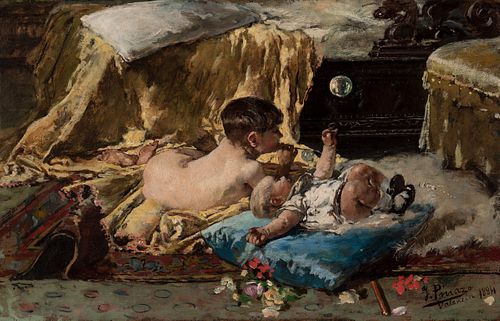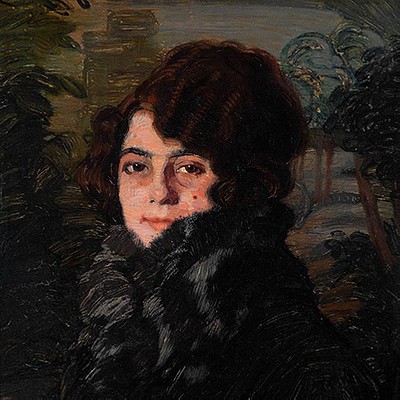IGNACIO PINAZO CAMARLENCH (Valencia, 1849 - Godella, Valencia, 1916). "José making soap bubbles", 1884. Oil on panel.
Lot 20
About Seller
Setdart Auction House
Carrer Aragó 346
Barcelona
Spain
Setdart Subastas was born in 2004 and is currently the first online art auction in Spain with solidity, prestige and reliability guaranteed by our more than 60,000 users. Setdart has a young, dynamic and enterprising team ready to successfully manage the purchase and sale of art works through custom...Read more
Estimate:
EUR€20,000 - EUR€25,000
$20,833.33 - $26,041.67
Absentee vs Live bid
Two ways to bid:
- Leave a max absentee bid and the platform will bid on your behalf up to your maximum bid during the live auction.
- Bid live during the auction and your bids will be submitted real-time to the auctioneer.
Bid Increments
| Price | Bid Increment |
|---|---|
| EUR€0 | EUR€10 |
| EUR€200 | EUR€25 |
| EUR€500 | EUR€50 |
| EUR€1,000 | EUR€100 |
| EUR€3,000 | EUR€200 |
| EUR€5,000 | EUR€500 |
| EUR€10,000 | EUR€1,000 |
| EUR€20,000 | EUR€2,000 |
| EUR€50,000 | EUR€5,000 |
About Auction
By Setdart Auction House
Jul 15, 2021
Set Reminder
2021-07-15 08:00:00
2021-07-15 08:00:00
America/New_York
Bidsquare
Bidsquare : 19th & 20th CENTURY PAINTINGS & ORIENTALISM
https://www.bidsquare.com/auctions/setdart-auction-house/19th-20th-century-paintings-orientalism-7212
Setdart Auction House sofia@setdart.com
Setdart Auction House sofia@setdart.com
- Lot Description
IGNACIO PINAZO CAMARLENCH (Valencia, 1849 - Godella, Valencia, 1916). "José making soap bubbles", 1884. Oil on panel. Signed, dated and located (Valencia), in the lower right corner. Measures: 22 x 33.5 cm; 42.5 x 54.5 cm (frame). The Prado Museum in Madrid, has two sketches of Ignacio Pinazo, in which you can see the drawing of a child making bubbles. These two works made around 1883, belong to a set of ten sketches, which were part of an artist's notebook, in which Pinazo, captured different notes, mostly dedicated to his relatives. These drawings gather the compositional essays that he would later transfer to larger pictorial works, as is the example of this painting. In the present work, the author portrays two children, his sons José and Ignacio, who would later devote themselves to painting. This theme defines a whole facet of the artist, in which he felt a predilection for the representation of his children. Captured in this case, in a work where the masterly touches of dark lines that outline fragments of bodies and canvases abound, combined with a use of light that produces dynamic effects of modernist preludes. Born into a humble family, Pinazo was forced from a very young age to contribute with different occupations to support his household. He had only completed the eighth grade at school when his mother died of cholera, so he soon had to be employed in various trades, including silversmith, tile decorator, baker, gilder and painter of fans. After the death of his father he went to live with his grandfather, and in 1864 he entered the San Carlos Academy of Fine Arts, where he was a disciple of José Fernández Olmos. During this period he earned his living as a milliner. He began his artistic training at the age of twenty-one, achieving his first success three years later, in Barcelona. In 1871 he entered the National Exhibition of Fine Arts for the first time. He was in Rome twice, the first time thanks to the sale of a painting, in 1873, and the second time with a scholarship, between 1876 and 1881. There he began his great productions of history, far from the conventions of the genre. In his first period he developed an academicist style, but from 1874 he began a more intimate and impressionist pictorial line. When he returned to Valencia he abandoned historical themes, and instead began to paint family subjects, nudes and scenes of everyday life. Thus, he is now considered a precursor, both in themes and style, of Joaquín Sorolla and Francisco Domingo. In 1884 Pinazo left Valencia temporarily due to a cholera epidemic, settling in the house that the banker José Jaumandreu owned in Bétera. From his return that same year until 1886, he taught at the School of Fine Arts in Valencia. During these years he received numerous commissions from the Valencian aristocracy, counting among his clients prominent figures such as the Marquise of Benicarló. Pinazo showed his works at the National Exhibitions of Fine Arts in Madrid, winning the silver medal in 1881 and 1885, and the gold medal in 1897 and 1899. In 1896 he was named academician of San Carlos, and in 1906 he will also be named academician of San Fernando, in Madrid. In 1900 he was involved in the decoration of the staircase of the palace of Don José Ayora, together with Antonio Fillol, Peris Brell, Ricardo Verde and Luis Beüt. For these years he received a royal medal and, in 1912, the city of Valencia dedicated a street to him. At his death, in 1916, the commemorative acts of his life and work will follow. Pinazo is currently represented in the Prado Museum, the MACBA in Barcelona, the Museum and the Circle of Fine Arts in Valencia, his House-Museum in Godella and the Provincial Council of Valencia, as well as in several important private collections.
- Shipping Info
-
In-house shipping available. Please inquire at admin@setdart.com.
-
- Buyer's Premium



 EUR
EUR CAD
CAD AUD
AUD GBP
GBP MXN
MXN HKD
HKD CNY
CNY MYR
MYR SEK
SEK SGD
SGD CHF
CHF THB
THB

















